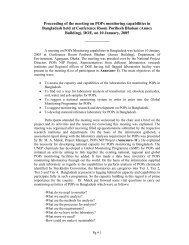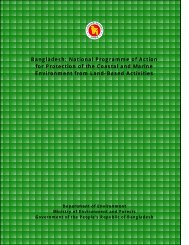Draft CMP HH - the Department of Environment
Draft CMP HH - the Department of Environment
Draft CMP HH - the Department of Environment
Create successful ePaper yourself
Turn your PDF publications into a flip-book with our unique Google optimized e-Paper software.
Coastal and Wetland Biodiversity Management Project BGD/99/G31<br />
Hakaluki Haor <strong>Draft</strong> Conservation Management Plan<br />
• Re-establishing viable populations <strong>of</strong> threatened plants and plant communities is time<br />
consuming, expensive and not necessarily be in <strong>the</strong> interests <strong>of</strong> local communities<br />
7.1.5 Ecological Monitoring Programme<br />
Ecological monitoring represents an important step towards assessing <strong>the</strong> status <strong>of</strong> biodiversity and<br />
critical habitats at Hakaluki Haor, as well as provides a scientifically sound basis upon which<br />
appropriate conservation management decisions can be made. Such decisions will include<br />
prioritising <strong>the</strong> recovery <strong>of</strong> endangered species and critical habitats, articulating strategies to<br />
safeguard and prevent fur<strong>the</strong>r plant and animal populations from becoming threatened, and<br />
justifying <strong>the</strong> deployment <strong>of</strong> funds and human resources to protect at risk species.<br />
An outline ecological programme has already been developed, but a significant amount <strong>of</strong> work is<br />
still required to articulate <strong>the</strong> details <strong>of</strong> <strong>the</strong> programme especially in relation to flagship species in<br />
particular birds, but also fish.<br />
Management Actions<br />
• Fur<strong>the</strong>r develop <strong>the</strong> ecological monitoring programme for Hakaluki Haor<br />
• Develop detailed workplans to effectively organise and coordinate ecological monitoring field<br />
visits<br />
• Begin implementing ecological monitoring activities with particular emphasis on flagship<br />
species especially birds, fish, and swamp forests<br />
• Involve local community groups to <strong>the</strong> greatest extent possible in <strong>the</strong> implementation <strong>of</strong> <strong>the</strong><br />
ecological monitoring programme<br />
• Provide necessary training to local community groups which enables <strong>the</strong>m to independently<br />
undertake ecological monitoring activities<br />
• Enter data into already established databases and create new databases as required<br />
• Analyse data periodically and assess change in status <strong>of</strong> biodiversity<br />
• Prepare regular reports including maps, graphs, tables and o<strong>the</strong>r appropriate means <strong>of</strong> presenting<br />
information which articulate changes observed and highlight key areas <strong>of</strong> conservation concern<br />
as required<br />
• Develop recommendations aimed at mitigating adverse changes in <strong>the</strong> status <strong>of</strong> biodiversity <strong>of</strong><br />
Hakaluki Haor<br />
• Make appropriate conservation management decisions based on analysed data<br />
Primary Outcome/ Output<br />
• Increased data concerning status and trends <strong>of</strong> biodiversity<br />
Constraints<br />
• Community groups may not be interested to participate in ecological monitoring activities<br />
• Sufficient technical expertise may not exist in DoE to ensure that ecological monitoring<br />
activities are sustained over <strong>the</strong> long-term<br />
• Field data may not be accurate enough for conservation management purposes<br />
Prepared by UNOPS Consultant Mr. Sulma Warne August/ September 2005 for Project BGD/99/G31 17





